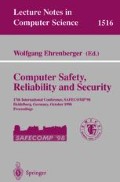Abstract
Many of today’s processes are safeguarded. The objective is to reduce the risk of an out-of-control process to an acceptable level with regard to human safety, environmental safety and economic benefits. Safeguarding systems are applied to obtain the required risk reduction. These systems are “fail safe” or “fault tolerant for safety” (i.e. one failure will not affect the system safety function). System-internal voting determines the overall system action. Two safe guarding architectures are applied in practice.
A comparison study has been done with regard to these architectures and, in particular, to their voting principles.
This study does not include influences of common causes. This paper shows that, for certain parameter values, there is a clear difference in safety performance between these voting principles.
Access this chapter
Tax calculation will be finalised at checkout
Purchases are for personal use only
Preview
Unable to display preview. Download preview PDF.
References
Leiming Xing, Karl N. Fleming, Wee Tee Loh, Comparison of Markov model and fault tree approach in determining initiating event frequency for systems with two train configurations. Reliability Engineering and System Safety 53 (1996) 17–29, Elsevier Science Limited
Rouvroye, J.L., Brombacher A.C., et al, Uncertainty in safety, New techniques for the assessment and optimisation of safety in process industry. SERA-Vol. 4, Safety Engineering and Risk Analysis, ASME, San Francisco, 1995
IEC 61508, Functional safety of electrical/electronic/programmable electronic safetyrelated systems.
IEC 61078, Analysis techniques for dependability-Reliability block diagram method, 1991.
IEC 61165, Application of Markov techniques, 1995.
Author information
Authors and Affiliations
Editor information
Editors and Affiliations
Rights and permissions
Copyright information
© 1998 Springer-Verlag Berlin Heidelberg Berlin Heidelberg
About this paper
Cite this paper
Knegtering, B., Brombacher, A. (1998). Conceptual Comparison of two Commonly Used Safeguarding Principles. In: Ehrenberger, W. (eds) Computer Safety, Reliability and Security. SAFECOMP 1998. Lecture Notes in Computer Science, vol 1516. Springer, Berlin, Heidelberg. https://doi.org/10.1007/3-540-49646-7_28
Download citation
DOI: https://doi.org/10.1007/3-540-49646-7_28
Published:
Publisher Name: Springer, Berlin, Heidelberg
Print ISBN: 978-3-540-65110-9
Online ISBN: 978-3-540-49646-5
eBook Packages: Springer Book Archive

